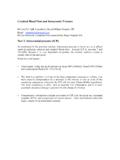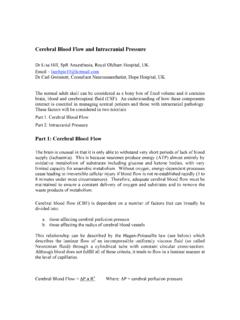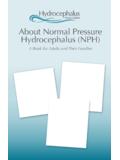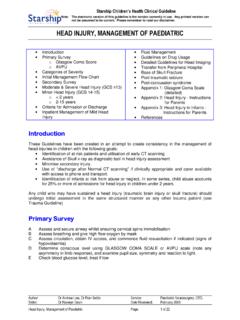Transcription of AEROSPACE MEDICAL SERVICE SPECIALTY …
1 QTP 4N0X1-13 24 October 2014 AEROSPACE MEDICAL SERVICE SPECIALTY CRITICAL CARE TECHNICIAN TOTAL FORCE, TOTAL CARE EVERYTIME, ANYWHERE 383 Training Squadron Training Management Section 42 2931 Harney Rd, BLDG 903 Fort Sam Houston, TX 78234 QTP 4N0X1-13 AEROSPACE MEDICAL SERVICE SPECIALTY Volume 13: MEDICAL SERVICE SPECIALTY Critical Care Technician TABLE OF CONTENTS MODULE OBJECTIVE PAGES 1 Set-up and assist with pulmonary artery (pa) catheter insertion/recognize hemodynamic waveforms 5 - 7 2 Identify Cardiac Rhythms, Waveforms and Trends 8 - 12 3 Operate Ventilator/Transfer Patient from Stationary Ventilator to a Portable Ventilator 13 - 14 4 Set-up and Assist with Intubation/Extubation 15 - 17 5 Set-up and Assist with Diagnostic Peritoneal Lavage 18 - 20 6 Monitor Patient on Mechanical Ventilation/Perform Ventilator Alarm/Circuit Troubleshooting 21 - 22 7 Set-up and Assist with Synchronized cardioversion 23 - 25 8 Perform and Obtain Measurements of Pulmonary Artery Pressure (PAP), Central Venous Pressure (CVP)
2 , Pulmonary Capillary Wedge Pressure and Cardiac Output 26 - 29 9 Perform and Obtain Mixed Venus Blood Sample 30 - 31 10 Perform and Obtain Ankle Brachial Index 32 - 33 11 Perform and Obtain Transurethral Bladder Pressures 34 - 36 12 Perform and Obtain ABG Percutaneous Collection/Arterial Pressure Measurement 37 - 39 2 13 Set-up and Assist with Ventriculostomy Drain/Fiber-Optic Intracranial Pressure (ICP) monitoring/Perform and Monitor ICP Pressure/Cerebral Perfusion Pressure (CPP) calculations 40 - 43 14 Set-up and Assist With Cold Caloric Testing (Oculovestibular Testing) 44 - 45 Supersedes QTP 4N0X1-13, 1 May 2005. 3 INTRODUCTION 1. These Qualification Training Packages (QTPs) were developed to enhance on-the-job training for AEROSPACE MEDICAL SERVICE SPECIALTY personnel. As a trainer, the QTPs provide you with the breakdown of tasks into teachable elements. The teachable elements will help you to guide the trainee toward sufficient proficiency for task performance without assistance.
3 QTPs are also used by the task certifiers/certification official to evaluate trainees concerning tasks which need third-party certification. 2. Review each volume and identify which modules of QTPs are needed for the trainee s job position. Core task items are identified with the number 5 on the STS Column 2; these items are the minimum mandatory skills which are required for all 4N0X1 personnel to be proficient in performing. You have the flexibility to arrange training for each module in the order that you decide. 3. Review the subject-area tasks in each module with the trainee. Direct the trainee to review the training references to gain a better understanding of the objective for each module. If the trainee has any questions about the objective, clarify the behavior that is expected in the objective. Review the performance checklist with the trainee, and allow him/her sufficient time to learn each step (some objectives may take longer to teach). Remember--the objective of each QTP is to standardize training and to allow sufficient time for the trainee to learn each task thoroughly in order to perform the task without assistance.
4 4. When the trainee receives sufficient training and is ready to be evaluated on an objective, follow the evaluation instructions. The performance checklist must be used as you evaluate each task objective. When the trainee successfully accomplishes the objective, document task completion appropriately in AFTR. 5. The QTP task completion is to be annotated on AF Form 1098, Special Task Certification and Recurring Training, filed in Part 3, Section B in AFTR. NOTE: The individual checklists are not filed in each member s AFTR. A master checklist is filed in Part 3, Section B of the hardcopy Master Training Plan (MTP) folder. 6. If the trainee does not accomplish the objective, review the areas which need remediation. Conduct a feedback concerning each module with the trainee, and document appropriately in AFTR. As the trainer, when you are satisfied that the trainee is qualified to perform the task, he/she will be re-evaluated until the objective is met. 7. If the task which is being trained requires third-party certification by a task certifier/certifying official, the trainer first must ensure that the trainee is qualified to perform the task without assistance.
5 Then the trainee will be evaluated by a task certifier/certifying official. The tasks which require third-party certification are denoted with a ^ in Column 3E of the Career Field Education and Training Plan (CFETP). After third-party certification, training qualification is documented appropriately in AFTR. 8. The QTPs are a necessary tool for standardizing refresher/sustainment training. Such standardization will benefit the CFETP training concept throughout each member s career. These documents also will be utilized for assessing/certifying the AEROSPACE MEDICAL SERVICE Specialist each time that he/she is assigned to a new duty position. The QTP developers goal is to publish a usable document for certifying officials, trainers, and trainees for the purpose of enhancing on-the-job training for AEROSPACE MEDICAL SERVICE SPECIALTY personnel. We value your first-hand expertise, and we encourage your feedback. Direct all inquiries to: 383d TRAINING SQUADRON/TRR c/o 4N0X1 CDC WRITER/MANAGER 2931 Harney Rd, BLDG 903 Fort Sam Houston, TX 78234 DSN: 420-5126 4 Volume 13 Module 1 SET-UP AND ASSIST WITH PULMONARY ARTERY (PA) CATHETER INSERTION/RECOGNIZE HEMODYNAMIC WAVEFORMS SUBJECT AREA: Critical Care.
6 TASK(s): Prepare supplies and equipment and assist with Pulmonary Artery (PA) Catheter insertion. CFETP/STS REFERENCE(s): , , , , & SEI 487 specific AF form 1098 overprint. EQUIPMENT REQUIRED: Transducer system, 500 mL % Normal Saline (NS), pressure bag, appropriate PPE (sterile gloves, sterile gowns & masks), prepackaged PA catheter and introducer kits, pressure cables compatible with hemodynamic monitor. TRAINING REFERENCE(s): AACN Procedure Manual for Critical Care, (6th edition), Mosby s Pulmonary Artery Catheter Insertion (Assisting) and Monitoring skills checklist, Hemodynamic monitoring system operating manual. REMARKS/NOTES: Review steps of the process one-on-one with MEDICAL technician and/or nursing personnel skilled and verified in assisting with PA catheter insertion. OBJECTIVE: The trainee will successfully demonstrate without error the performance aspects of assisting with PA catheter insertion and recognition of PA waveforms.
7 EVALUATION INSTRUCTIONS: 1. After the trainee has received instruction, allow sufficient practice on each part of the task. 2. The evaluator will STOP the procedure immediately and correct the trainee if performance could become detrimental to patient safety at any time. 3. Use the performance checklist to ensure all steps of the task are accomplished. 4. Document task competency upon completion of the evaluation in the trainee s AFTR. Initial evaluation should be documented in the 797. All recurring evaluations should be documented on AF Form 1098. 5 Vol. 13 Mod 1 Set-up and assist with pulmonary artery (pa) catheter insertion/recognize hemodynamic waveforms PERFORMANCE ITEM SAT UNSAT 1. Verify physician s order. 2. Identify patient/explain procedure. 3. Wash hands/don gloves. 4. Gather supplies/equipment. 5. Prime and flush the transducer system. 6. Apply and maintain 300 mgHg pressure in pressure bag. 7. Assist physician in opening the PA catheter and introducer kits using sterile technique.
8 8. When sheath introducer is in place assist by connecting NS to the infusion port. 9. Connect pressure transducer/flush system to PA distal & proximal ports of catheter and flush all lumens. 10. Connect pressure cables from PA distal & proximal transducers to monitor. 11. Connect thermistor connector of PA catheter to CO monitor/module. 12. Set scales for each pressure tracing per physician orders. 13. Level and zero to air to the phlebostatic axis (off to patient, open to air, and zero the monitoring system) 14. Continually run ECG and distal waveform strip while physician is inserting catheter. 15. Monitor patient for distress. 16. At physician s orders, inflate balloon with no more than to of air and close stopcock when the tip of the PA catheter is in the right atrium. 17. Observe for Right atrium (RA), Right Ventricle (RV), Pulmonary Artery (PA), and Pulmonary Capillary Wedge (PCW) waveforms **Note Plmonary Artery Occlusion (PAO) is the also known as Pulmonary Capillary Wedge (PCW)** 6 18.
9 Verify proper position. When balloon is deflated the monitor shows a PA tracing; when balloon is inflated the monitor shows a PCW tracing. 19. After placement is verified by physician, open balloon inflation stopcock and remove PA syringe. 20. Reassess proper leveling of transducer and secure to chest, arm or IV pole. 21. Zero monitoring system and perform a dynamic response test (square wave test) 22. Apply sterile dressing to the site. 23. Document procedure and note the external centimeter marking of PA catheter at introducer exit site. 24. Set up alarm parameters per physician orders. 25. Ensure physician ordered chest x ray and that it is completed. 26. Document the procedure and line placement. FINAL RESULTS: FEEDBACK: Using this checklist as a source of information, discuss the trainee's performance indicating strengths, weaknesses, suggested improvements, etc. If the trainee performed all steps of the task satisfactorily, document the results in the trainee s AFTR.
10 7 Volume 13 Module 2 MONITOR PATIENT ON TELEMETRY/IDENTIFY CARDIAC RHYTHMS/IDENTIFY WAVEFORMS/IDENTIFY TRENDS SUBJECT AREA: Critical Care. TASK(s): Identify cardiac rhythms, waveforms and trends. CFETP/STS REFERENCE(s): , , & SEI 487 specific AF form 1098 overprint. EQUIPMENT REQUIRED: ECG electrodes and ECG lead wires compatible with bedside and central monitors, non-emollient soap, ECG calipers, razor or clippers, skin prep and alcohol pads. TRAINING REFERENCE(s): AACN Procedure Manual for Critical Care (6th edition), ECGs Made Easy (5th edition), Emergency Care and Transportation of the Sick and Injured by American Academy of Osteopathic Surgeons (AAOS) (10th edition), and Brady Emergency Care (12th edition). REMARKS/NOTES: Review steps of the process one-on-one with MEDICAL technician & nursing personnel that are skilled and certified in monitoring patients on telemetry.















